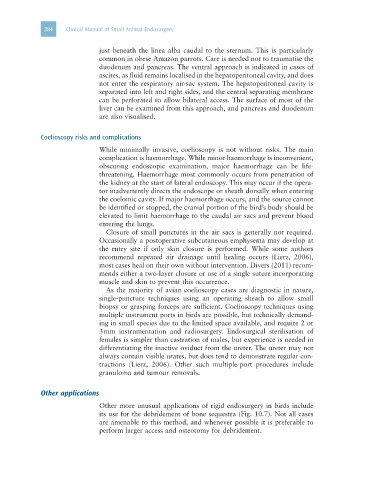Page 296 - Clinical Manual of Small Animal Endosurgery
P. 296
284 Clinical Manual of Small Animal Endosurgery
just beneath the linea alba caudal to the sternum. This is particularly
common in obese Amazon parrots. Care is needed not to traumatise the
duodenum and pancreas. The ventral approach is indicated in cases of
ascites, as fluid remains localised in the hepatoperitoneal cavity, and does
not enter the respiratory air-sac system. The hepatoperitoneal cavity is
separated into left and right sides, and the central separating membrane
can be perforated to allow bilateral access. The surface of most of the
liver can be examined from this approach, and pancreas and duodenum
are also visualised.
Coelioscopy risks and complications
While minimally invasive, coelioscopy is not without risks. The main
complication is haemorrhage. While minor haemorrhage is inconvenient,
obscuring endoscopic examination, major haemorrhage can be life-
threatening. Haemorrhage most commonly occurs from penetration of
the kidney at the start of lateral endoscopy. This may occur if the opera-
tor inadvertently directs the endoscope or sheath dorsally when entering
the coelomic cavity. If major haemorrhage occurs, and the source cannot
be identified or stopped, the cranial portion of the bird’s body should be
elevated to limit haemorrhage to the caudal air sacs and prevent blood
entering the lungs.
Closure of small punctures in the air sacs is generally not required.
Occasionally a postoperative subcutaneous emphysema may develop at
the entry site if only skin closure is performed. While some authors
recommend repeated air drainage until healing occurs (Lierz, 2006),
most cases heal on their own without intervention. Divers (2011) recom-
mends either a two-layer closure or use of a single suture incorporating
muscle and skin to prevent this occurrence.
As the majority of avian coelioscopy cases are diagnostic in nature,
single-puncture techniques using an operating sheath to allow small
biopsy or grasping forceps are sufficient. Coelioscopy techniques using
multiple instrument ports in birds are possible, but technically demand-
ing in small species due to the limited space available, and require 2 or
3 mm instrumentation and radiosurgery. Endosurgical sterilisation of
females is simpler than castration of males, but experience is needed in
differentiating the inactive oviduct from the ureter. The ureter may not
always contain visible urates, but does tend to demonstrate regular con-
tractions (Lierz, 2006). Other such multiple-port procedures include
granuloma and tumour removals.
Other applications
Other more unusual applications of rigid endosurgery in birds include
its use for the debridement of bone sequestra (Fig. 10.7). Not all cases
are amenable to this method, and whenever possible it is preferable to
perform larger access and osteotomy for debridement.

